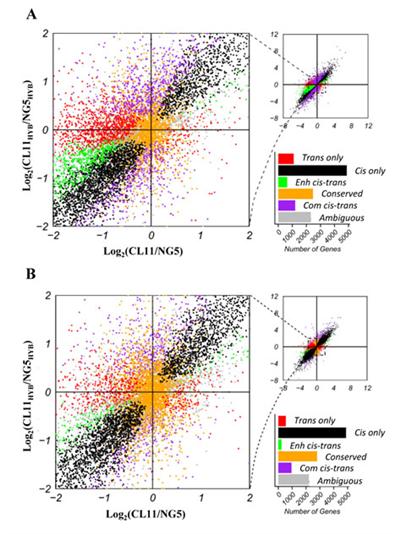Transcriptome profiling and comparison of maize ear heterosis during the spikelet and floret differentiation stages
作 者:Xiaojiao Hu*, Hongwu Wang*, Xizhou Diao, Zhifang Liu, Kun Li, Yujin Wu, Qianjin Liang, Hui Wang and Changling Huang
影响因子: 3.867
刊物名称: BMC Genomics
出版年份: 2016
卷: 17 期:1 页码: 1-18
文章摘要 :
Background: Hybridization is a prominent process in the evolution of crop plants that can give rise to gene expression variation, phenotypic novelty and heterosis. Maize is the most successful crop in utilizing heterosis. The development of hybrid maize ears exhibits strong heterotic vigor and greatly affects maize yield. However, a comprehensive perspective on transcriptional variation and its correlation with heterosis during maize ear development is not available. Results: Using RNA sequencing technology, we investigated the transcriptome profiles of maize ears in the spikelet and floret differentiation stages of hybrid ZD808 and its parents CL11 and NG5. Our results revealed that 53.9% (21,258) of maize protein-coding genes were transcribed in at least one genotype. In both development stages, significant numbers of genes were differentially expressed between the hybrid and its parents. Gene expression inheritance analysis revealed approximately 80% of genes were expressed additively, which suggested that the complementary effect may play a foundation role in maize ear heterosis. Among non-additively expressed genes, NG5-dominant genes were predominant. Analyses of the allele-specific gene expression in hybrid identified pervasive allelic imbalance and significant preferential expression of NG5 alleles in both developmental stages. The results implied that NG5 may provide beneficial alleles that contribute greatly to heterosis. Further comparison of parental and hybrid allele-specific expression suggested that gene expression variation is largely attributable to cis-regulatory variation in maize. The cis-regulatory variations tend to preserve the allelic expression levels in hybrid and result in additive expression. Comparison between the two development stages revealed that allele-specific expression and cis-/trans-regulatory variations responded differently to developmental cues, which may lead to stage-specific vigor phenotype during maize ear development. Conclusion: Our research suggests that cis-regulated additive expression may fine-tune gene expression level into an optimal status and play a foundation role in maize ear heterosis. Our work provides a comprehensive insight into transcriptional variation and its correlation with heterosis during maize ear development. The knowledge gained from this study presents novel opportunity to improve our maize varieties.





